|
WOOD-BORING
BEETLES IN HOMES
IDENTIFICATION AND LIFE CYCLES
MANAGEMENT
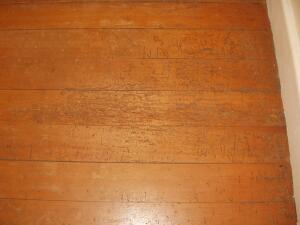
Borer Beetle often falsely referred to
as "Dry Rot" can be a terminal
problem, however, one often only need
replace the odd board.
Treatment against beetle requires that the floors be
sanded before application of the poison. |
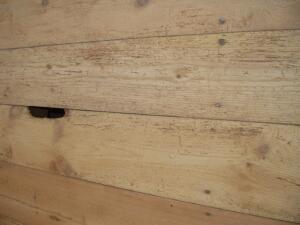
Reading the article below, there appears
no treatment that can be conclusive, yet
"No" treatment will also be very
conclusive. I just had a flashback - how
much does it cost to replace Oregon Pine
floorboards? R650.00 per m2. |
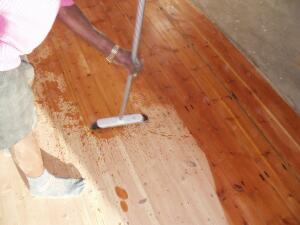
The Poison is literally pored onto the
sanded floor prior to sealing the floor.
|
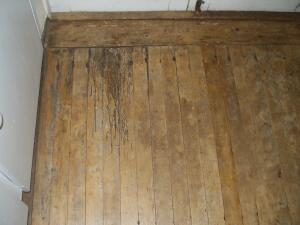
It's not only Pine that is affected by Borer
Beetle - this is a Beach Floor |
Wood-boring beetle larvae feed on wood and wood products; adults emerge from larval feeding chambers through round, oblong, or D-shaped exit holes. Adults of some species also bore holes into plaster, plastic, and soft metals.
Many species of wood-boring beetles, 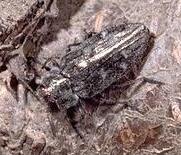 especially those in the family Buprestidae
(flat headed or metallic wood borers) or the family Cerambycidae (which includes long-horned beetles and
round headed wood especially those in the family Buprestidae
(flat headed or metallic wood borers) or the family Cerambycidae (which includes long-horned beetles and
round headed wood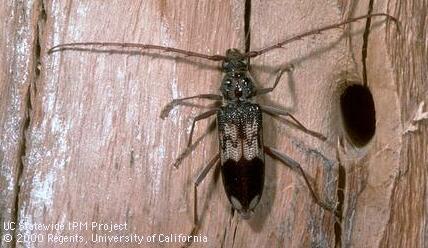 borers), feed on live trees that are old or weakened or fire- or insect-killed trees but do not attack harvested lumber. They cause problems, however, when they emerge from wood in newly constructed buildings, leaving small circular or oval exit holes in the wood. Infested wood must be kiln-dried before it is used for lumber to avoid these problems. Species of these beetles may also be observed in the home if infested firewood is stored inside; however, they will not attack wood structures or furniture. borers), feed on live trees that are old or weakened or fire- or insect-killed trees but do not attack harvested lumber. They cause problems, however, when they emerge from wood in newly constructed buildings, leaving small circular or oval exit holes in the wood. Infested wood must be kiln-dried before it is used for lumber to avoid these problems. Species of these beetles may also be observed in the home if infested firewood is stored inside; however, they will not attack wood structures or furniture.
Three families of beetles have species of wood borers that invade and damage structural and decorative wood and furniture. These families are the
powder post beetles, deathwatch beetles, and false
powder post beetles.
Back to Top
IDENTIFICATION AND LIFE CYCLES
Powder post Beetles
Beetles in the family Lyctidae are known as powder post
beetles. They are so named because larvae leave a fine,
dust like powdered frass (a mixture of feces and food fragments) in their galleries that occasionally falls out of exit holes into small piles on floors or other surfaces. This powdered frass is characteristic of
powder post beetles and helps distinguish them from other typical wood-boring beetles.
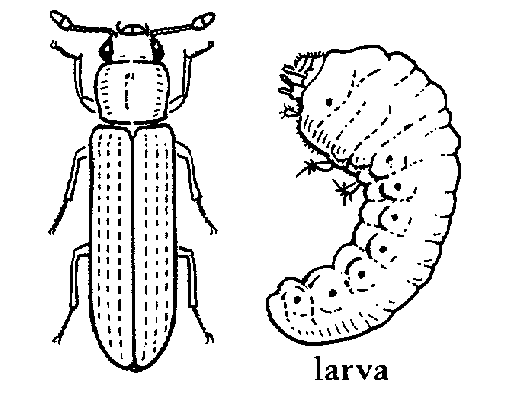 Lyctids attack hardwoods apparently because these woods have pores
into which they can lay eggs; softwoods do not have such pores. Also, the starch content in softwoods is nutritionally low for these beetles. They will attack woods that are very dry (as low as 8% moisture). Lyctids attack hardwoods apparently because these woods have pores
into which they can lay eggs; softwoods do not have such pores. Also, the starch content in softwoods is nutritionally low for these beetles. They will attack woods that are very dry (as low as 8% moisture).
Adult Lyctids usually range from brownish to reddish in color. Woods most often attacked by this beetle are oak, ash, hickory, mahogany, and walnut; infestations are most likely to occur in wood paneling, molding, window/door frames, plywood, hardwood floors, bamboo articles, and furniture. Infestations may occur if beetles or larvae are brought into a building in furniture or firewood. Sometimes the only sign of infestation may be the tiny, round exit holes made by emerging adult beetles. Once they emerge, the winged adult beetles spread to other wood surfaces where they deposit eggs onto unfinished surfaces or in cracks or other openings. They have a life cycle ranging from 3 months to over 1 year, depending on temperature, humidity, and the nutritional quality of the wood.
Deathwatch Beetles
Wood-boring beetles in the family Anobiidae are known as deathwatch beetles. Deathwatch beetles are closely related to the drugstore and cigarette beetles, which are stored-product pests. Adults communicate with each other and probably locate mates by tapping their heads against wood, usually at night. (Deathwatch beetles supposedly acquired their name during medieval European times from people who heard the tapping while sitting up with a sick or dying person during the night.)
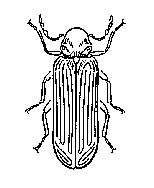 Adults are reddish to dark brown and lay eggs in crevices or small openings or pores in unfinished wood. Two years may be required to complete each generation. Adults are reddish to dark brown and lay eggs in crevices or small openings or pores in unfinished wood. Two years may be required to complete each generation.
Deathwatch beetles are found primarily in soft woods, including girders, beams, foundation timbers, and some types of furniture. Some species attack books. This beetle is typically found in old wood and may be associated with wood that is partially decayed. Deathwatch beetles prefer wood that is more moist (greater than 14% moisture) than what
powder post beetles prefer and may be less of a problem in houses with central heating and air conditioning. Larvae of deathwatch beetles fill their galleries with small pellets of frass (smaller than the pellets produced by
dry wood termites), which distinguish them from other wood borers. None of the other boring beetles produce
palletized frass.
Back to Top
False Powder post Beetles
Wood-boring beetles in the family Bostrichidae are sometimes known as false
powder post beetles. Larvae tightly pack their galleries with frass that has the consistency of coarse powder; this coarse texture distinguishes them from true
powder post beetles as well as the deathwatch beetles.
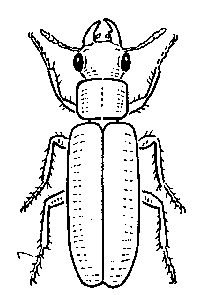 Adults are dark brown or black, sometimes with reddish mouthparts, legs, and antennae. Adults of most species are about 1/4 inch long, but in some species, adults reach 1-1/2 to 2 inches in length. Adult beetles have a humpback appearance, so their head is not visible when viewed from above. This characteristic is also seen in deathwatch beetles. Adults are dark brown or black, sometimes with reddish mouthparts, legs, and antennae. Adults of most species are about 1/4 inch long, but in some species, adults reach 1-1/2 to 2 inches in length. Adult beetles have a humpback appearance, so their head is not visible when viewed from above. This characteristic is also seen in deathwatch beetles.
Females bore a tunnel, or egg gallery, into wood or other materials, then deposit their eggs in pores or cracks within the tunnel. Adults of some species bore through soft metal, such as lead and silver, as well as plaster and other
non-wood materials, searching for sites to deposit eggs or for protection from weather extremes. This gives rise to the common name
"lead cable borer" 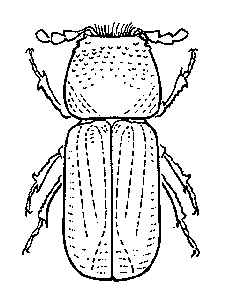 given to one species because of its habit of boring into the metal covering of suspended telephone wires. In buildings, false
powder post beetles infest floors, furniture, hardwood paneling, and other wood materials. given to one species because of its habit of boring into the metal covering of suspended telephone wires. In buildings, false
powder post beetles infest floors, furniture, hardwood paneling, and other wood materials.
Two quick diagnostic tests, the ballpoint pen test and the frass test, can help distinguish the three groups of wood-boring beetles. These are described in Table 1.
Method
1 Insert the tip of a click-type refillable ballpoint pen into the exit hole of the beetle.
2 To determine the texture of frass, a mixture of feces and food fragments, rub the frass between your fingers.
Table 1
|
Beetle |
Ballpoint pen test1 |
Frass test2 |
|
powder post beetles (Lyctids) |
only tip of pen fits in exit hole |
feels like talc |
|
deathwatch beetles (Anobiids) |
the tip and part of the angled face fits in exit hole |
feels gritty |
|
false powder post beetles (Bostrichids) |
Entire point of pen usually fits in exit hole |
frass is difficult to dislodge from hole |
Back to Top
MANAGEMENT
Wood-boring beetles are difficult to control once an infestation has begun. Prevention is the best management method. Protective measures should be taken at every stage of lumber processing and handling including lumber mills, plywood mills, lumber yards, furniture manufacturing factories, and building construction firms. Sanitation is the most important aspect of prevention. Remove and destroy dead tree limbs around buildings or near any area where wood products are stored. Destroy scrap lumber and other wood products before they become infested. Kiln drying of lumber destroys beetle infestations, although it does not prevent
re-infestation. Materials used for construction of buildings and wood furniture should be thoroughly inspected before use to be certain that they do not contain wood-boring beetles. Protect wood from infestation by painting or varnishing to seal pores, cracks, and holes where eggs could be laid.
To keep from accidentally introducing wood borers, inspect furniture and other objects before bringing them into buildings. Fumigate objects that show signs of beetle infestation. When bringing in firewood, only bring in what will be burned that day. Also, inspect the building for signs of wood borer damage. Look for exit holes where adult beetles have emerged. Once galleries have been located, tap out frass to aid in identifying the pest (see Table 1).
Small wooden items (but not those containing fabrics, pelts, or paints) can be heated in an oven at 120° to 140°F for 6 hours or placed in a deep freeze at 0°F for 72 hours. Longer treatments may be required if the wood is thicker than 2 inches. Although room-sized or whole-house treatments for
powder post beetle control are commercially available, there has been no published research on their effectiveness.
Remove and replace infested structural wood whenever possible to eliminate beetles. Destroy infested wood by burning or take it to a landfill area. Where removal is not possible, use liquid insecticides containing materials such as permethrin, cypermethrin, or cyfluthrin that are labeled for the control of these pests.
Pesticide formulations containing borate (e.g., Tim-Bor, Bora-Care), which must be applied by a
pest control operator, can potentially penetrate the wood and kill beetles within the wood. Depth of penetration is enhanced in moist wood; if moisture is less than 15%, penetration may only be in the top 1/4 inch. Remove and have infested furniture fumigated. For extensive
powder post and deathwatch beetle infestations within a building, or where inaccessible structural parts of a building are involved, whole-building fumigation is offered by many professional pest control operators. However, there is no published research on the effectiveness of this method for false
powder post beetles, round headed wood borers, and
flat headed wood borers. Whenever applying dusts, liquid insecticides, or fumigants, be sure to follow label instructions carefully. Wear the required protective clothing and respiratory equipment.
Back to Top
|